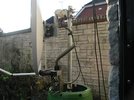dovercat
Member
- Joined
- Nov 24, 2007
- Messages
- 28
- Reaction score
- 0
- Points
- 0
- Age
- 52
- My Satellite Setup
-
Televes 1mtr dish (102x113cm, Gain at 11GHz 40.5dB, Beamwidth 1.98degrees)
Televes 0.5dB LNB
(gain 57dB, discrimination 25dB, oscillator stability +/-2MHz, phase noise max-75dBc@10KHz)
Moteck 2100 Diseqc
Comag sl100hd
- My Location
- 51.6 N, 1.2 W Didcot UK
Sounds like my Moteck sg2100a is an atypical lemon then, just my bad luck. It had play from new, and has developed a problem young about 3years old.
Does anyone else have problems with it not reliably and accurately to 0.15 degrees going to its stored positions? Maybe that is a problem with my receiver?
I do think the Moteck looks and weighs like a toy in comparison to old 36v motorized mounts, considering how heavy duty they are in comparison. Maybe they were overkill or designed to withstand a once in a lifetime storm. The wind loading on a 1.2mtr solid dish in say gale force winds is massive. I have had a 1mtr solid dish in an exposed location when gales were toppling trees, chimney stacks etc.. That buckled my old polar mount, with this mount I would worry it might snap.
Still it was alot cheaper and the motor is quieter than the old 36v Jaegar smr-g99 h-h it replaced.
So the Triax is marginally smaller and a bit heavier than the Televes.
I went with the Televes over the Triax because I could get it significantly cheaper and figured the most important factors with a dish are size and build material. Triax quote gain at 11.7GHz while Televes use 11GHz, since I believe gain increases with frequency this makes the specs not directly compariable, does anyone know how to convert gain from 11GHz to 11.7GHz.
You also seem to use Lnbs that are not dish specific, I found the Televes 0.5dB better suited to the Televes dish than other 0.1-0.2dB Lnbs I had lying around. I thought having a good Lnb-Dish match and tweaking the Lnb position for best signal quality would yield about as good as I would get. How much improvement do you get with these Lnbs since the specs are not very reliable/revealing. I was under the impression that a Lnb upgrade was generally not worthwhile as it is generally only equivelent to increasing dish size by a few cm. So only worthwhile if their are channels right on the borderline of having a reliable-stable picture.
Does anyone else have problems with it not reliably and accurately to 0.15 degrees going to its stored positions? Maybe that is a problem with my receiver?
I do think the Moteck looks and weighs like a toy in comparison to old 36v motorized mounts, considering how heavy duty they are in comparison. Maybe they were overkill or designed to withstand a once in a lifetime storm. The wind loading on a 1.2mtr solid dish in say gale force winds is massive. I have had a 1mtr solid dish in an exposed location when gales were toppling trees, chimney stacks etc.. That buckled my old polar mount, with this mount I would worry it might snap.
Still it was alot cheaper and the motor is quieter than the old 36v Jaegar smr-g99 h-h it replaced.
So the Triax is marginally smaller and a bit heavier than the Televes.
I went with the Televes over the Triax because I could get it significantly cheaper and figured the most important factors with a dish are size and build material. Triax quote gain at 11.7GHz while Televes use 11GHz, since I believe gain increases with frequency this makes the specs not directly compariable, does anyone know how to convert gain from 11GHz to 11.7GHz.
You also seem to use Lnbs that are not dish specific, I found the Televes 0.5dB better suited to the Televes dish than other 0.1-0.2dB Lnbs I had lying around. I thought having a good Lnb-Dish match and tweaking the Lnb position for best signal quality would yield about as good as I would get. How much improvement do you get with these Lnbs since the specs are not very reliable/revealing. I was under the impression that a Lnb upgrade was generally not worthwhile as it is generally only equivelent to increasing dish size by a few cm. So only worthwhile if their are channels right on the borderline of having a reliable-stable picture.


